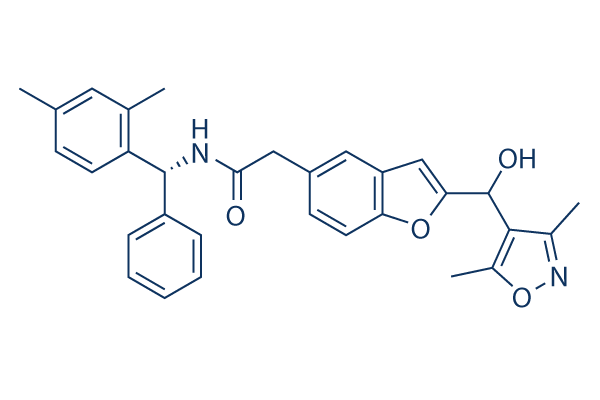| Description: |
TMP778 is a potent and selevtive RORγt inverse agonist, with an IC50 of 7 nM in FRET assay. |
| Target: |
IC50: 7 nM (FRET assay), 63 nM (IL-17F promoter assay), 0.03 μM (in Th17 cells), 0.005 μM (in Tc17 cells)[1]. |
| In Vivo: |
All three compounds (e.g., TMP778) delay the onset of disease and substantially reduce the severity of disease progression compared to control-treated mice. Consistent with in vitro results, TMP778 treatment causes the most pronounced effect on the disease phenotype. This treatment not only decreases the number of mononuclear cells infiltrating the central nervous system (CNS), but also most strongly reduces the percentage of IL-17+ T cells in the CNS (including IL-17+ IFNγ+). There is no significant change in the percentage IFNγ+ IL-17-T cells in the CNS among all groups, indicating that none of the inhibitors affects Th1 responses. TMP778 strongly inhibits Th17 cell generation, reduces IL-17 production from differentiated Th17 cells, and also dramatically ameliorates the progression of EAE[2]. |
| In Vitro: |
It is found that TMP778 at >2.5 μM starts to show toxic effects on cell growth, which however is not RORγt-dependent, since the proliferation of RORγt-deficient T cells cultured under Th17 cell-polarizing conditions is also decreased. Otherwise, these inhibitors do not show inhibitory effects on cell proliferation or RORγt expression or its nuclear translocation, but efficiently inhibited IL-17 production. TMP778 has a much broader dose range and efficiently decreased IL-17 production, consistent with its higher binding affinity for RORγt. These data indicate that TMP778 is the RORγt inhibitor that most potently reduced IL-17 production[2]. |
| Cell Assay: |
Naive CD4+ T cells are activated in 96-well plates under Th17 cell polarizing conditions in the presence of indicated doses of RORγt inhibitors (e.g., TMP778: 30, 10, 2.5, 0.83, 0.28, 0.09 μM ) or vehicle control DMSO. After 48 h, plates are pulsed for 16 h with 1 μCi 3H-thymidine per well. Proliferation is measured as counts per minute by using a Wallac Liquid Scintillation Counter[2]. |
| Animal Administration: |
Mice[2] EAE is induced in C57BL/6 mice with MOG35-55 plus CFA immunization in conjunction with subcutaneous administration of the inhibitors twice daily from day 0. C57BL/6 mice are immunized with MOG35-55 plus CFA, and RORγt inhibitor (TMP778, 200 μg per injection, n=19; TMP920, 500 μg per injection, n=7; Digoxin, 50 μg per injection, n=5, >100 μg cause mouse death; DMSO, n=19) are subcutaneously injected twice daily starting from day 0. Mice are evaluated daily for signs of EAE. When 11 days after groups of mice treated with different RORγt inhibitors are compared with the group of mice with DMSO (vehicle control) treatment[2]. |
| References: |
[1]. Skepner J, et al. Pharmacologic inhibition of RORγt regulates Th17 signature gene expression and suppresses cutaneous inflammation in vivo. J Immunol. 2014 Mar 15;192(6):2564-75.
[2]. Xiao S, et al. Small-molecule RORγt antagonists inhibit T helper 17 cell transcriptional network by divergent mechanisms. Immunity. 2014 Apr 17;40(4):477-89. |






















